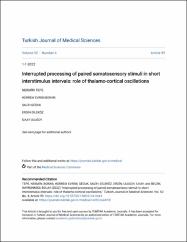Interrupted processing of paired somatosensory stimuli in short interstimulus intervals: Role of thalamo-cortical oscillations

View/
Access
info:eu-repo/semantics/openAccesshttp://creativecommons.org/licenses/by/3.0/us/Date
2022Metadata
Show full item recordAbstract
Background/aim: Discrimination of consecutive sensory stimuli is imperative for proper sensory perception and behavioral response. We aimed to investigate the emergence of paired somatosensory responses in relation to the interstimulus interval (ISI) change.
Materials and methods: Paired stimulus with 35 ms, 50 ms, 80 ms, 140 ms, and 500 ms ISI was applied to the median nerve and evoked responses were recorded from the primary somatosensory cortex in rats. Early and late components of both responses were analyzed in different frequency bands.
Results: The amplitudes were comparable for the 1st responses (S1), while the amplitude of the 2nd responses (S2), and S2/S1 sensory gating ratio were significantly lower at 35 and 50 ms ISI values. S2/S1 ratio was close to 1 at 500 ms ISI. The duration and latency of the 2nd response was also different at 35 ms ISI. In the 2nd responses, area of early high-frequency oscillations (150-400 Hz) was significantly lower at 35 ms ISI values.
Conclusion: The shaping of 2nd somatosensory response is dependent on ISIs. Early high-frequency oscillations changes without accompanying late high-frequency oscillations alterations, may indicate that reduced thalamo-cortical drive to the cortex take a part in determining the 2nd response at short ISI. Further research is required by using neuropsychiatric disorder models where somatosensory perception is impaired.
Source
Turkish Journal of Medical SciencesVolume
52Issue
4Collections
The following license files are associated with this item:


















